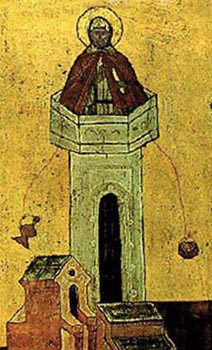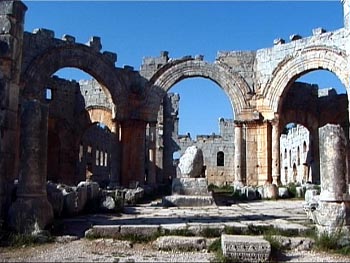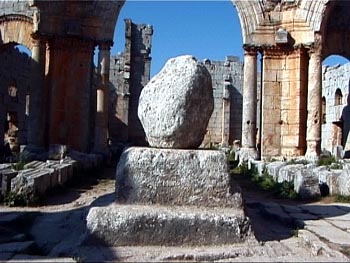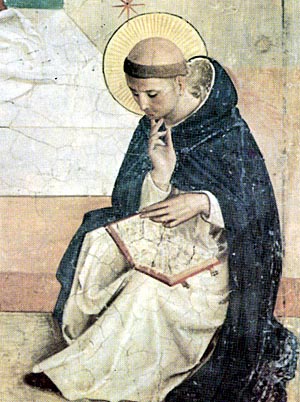 |
The Saint of the Day
St. Simeon Stylites, January 5
Prof. Plinio Corrêa de Oliveira
Biographical selection:

St. Simeon Stylite
|
Stylites comes from the Greek word stylos, which means pillar, or column. It was on top of a pillar that St. Simeon spent the largest part of his extraordinary life.
Simeon was born at Sisan near the northern border of Syria and began life as a shepherd boy for his father’s flock of sheep. When he was just 13-years-old, he heard the Gospel passage: “Blessed are they that mourn; blessed are the clean of heart.” He went to a wise old man and asked him the meaning of these words. He explained to the boy that eternal happiness can only be achieved with suffering, and that solitude is the most secure way to attain it. Impressed with this explanation, the young man joined some hermits who lived in a nearby monastery.
After some years in different monasteries, however, he retired to live alone and avoid the numerous visitors who were constantly seeking him out. He determined to take up his abode on the top of a pillar. There he remained most of the time standing, exposed to inclement weather, and absorbed in continuous prayer. He died in 459 at age 69, having lived 36 years of his life on the top of different pillars.
Comments of Prof. Plinio:
The life of St. Simeon Stylites is one of those marvelous facts that happened in the first centuries of the life of the Church. They constituted a manifestation of the supernatural atmosphere communicated directly by Our Lord when He was present on earth. Those early centuries still echoed the incomparable effect of His presence and for this reason witnessed extraordinary graces. I consider the life of St. Simeon and his very special vocation one of these manifestations.

After Simeon’s death, pilgrims continued to flock to his pillar. In 472 a great basilica was built in Syria. Its ruins still remain today (above) with what is left of the pillar (below).

|
His life was exceptional from many points of view. Actually, to stand as he did on the top of a pillar is to make himself a kind of statue. It is a position that many proud people might like to assume in order to be admired. But this was not the case with St. Simeon, who fled the monastery to avoid the numerous, inopportune visitors who sought him out.
You can see that his life was inspired by an extraordinary grace. It was a grace of a continuous and open contemplation of God. His life was entirely exposed, almost without a moment of privacy. He was accessible to the regard of anyone who wanted to observe him and check his attitude. The text tells us that he almost never stopped praying. For those Eastern peoples - and also for all of us after his fame spread throughout the world - his life represents a compelling invitation to pray and consider the importance of prayer, the importance of the supernatural life. It invited many others to seek solitude and abandon earthly things.
About this isolation, I would like to say a word. In times past solitude was highly admired and praised. St. Bernard used to say: O, beata solitudo; o, sola beatitudo! “O, happy solitude! O, only happiness!” A person can only be truly happy when he removes himself from the world. One could say that an indicator to show the worth of a civilization is the taste of its people for a life of solitude.
The modern man tries to escape silence and solitude. He likes to be with others all day long. When he is alone, he breaks the solitude by turning on the radio or TV, or some other such means. His house is not a place to be recollected, but just a place to eat, drink, sleep, and stop before running out again.
The idea to be by oneself and think – because when one is isolated and silent, one thinks – only is welcome in civilizations that have value. Consider, for example, ancient Japan. I knew a Catholic Japanese Admiral who told me that when the first Trappists appeared in Japan, their way of life raised enthusiasm among the people. Many wanted to enter the Trappist monastery even without being Catholic, because they liked to be alone and to think.

The church always praised solitude and silence as a means to draw closer to Our Lord and Our Lady.
|
When someone is isolated, his natural tendency is to be serious. The secluded and silent man is normally serious. He realizes that this allows him a closer union with Our Lord and Our Lady. Many times Our Lady chooses persons who are removed from others and calls them to a higher vocation. Other times she permits someone to be isolated so that he might lose his attachment to earthly things and worldly friendships. It is a golden opportunity to be more humble, to distance oneself from the world, and to acquire a nobler and more elevated spirit. These are some of the good fruits of solitude.
There is also another sort of isolation that often occurs. It is that of the person who does not fit in the world. Such a person is misunderstood and not well-accepted by his relatives, acquaintances, and colleagues, and consequently becomes isolated. He may complain that his situation is unjust, etc. This can well be, but it is not the problem we are analyzing here. Quite often such a person doesn’t see that this involuntary isolation can be a gift Our Lady is giving him as an invitation to unite himself more with her.
It seems to me that today the souls that truly are Our Lady’s souls are isolated. When you approach such a person, he is amiable, but even then you notice that a higher part of his soul maintains a silent and mysterious reserve, because he has a zone of intimacy with Our Lady. This part of his soul acts as a kind of interior sanctuary that is the most precious thing he has.
Therefore, there are many advantages to solitude and various types of isolation that can produce extraordinary good fruit for the soul.
St. Simeon had the mission to show the entire Church the value of solitude and isolation. Let us ask him to help us understand and have the taste for that kind of spiritual position so that we will be serious and achieve the union we are called to have with Our Lord and Our Lady.


  |
| Prof. Plinio Corrêa de Oliveira | |
The Saint of the Day features highlights from the lives of saints based on comments made by the late Prof. Plinio Corrêa de Oliveira. Following the example of St. John Bosco who used to make similar talks for the boys of his College, each evening it was Prof. Plinio’s custom to make a short commentary on the lives of the next day’s saint in a meeting for youth in order to encourage them in the practice of virtue and love for the Catholic Church. TIA thought that its readers could profit from these valuable commentaries.
The texts of both the biographical data and the comments come from personal notes taken by Atila S. Guimarães from 1964 to 1995. Given the fact that the source is a personal notebook, it is possible that at times the biographic notes transcribed here will not rigorously follow the original text read by Prof. Plinio. The commentaries have also been adapted and translated for TIA’s site.
|
Saint of the Day | Home | Books | CDs | Search | Contact Us | Donate

© 2002- Tradition in Action, Inc. All Rights Reserved
|
 |
|